I have worked really hard over the past 8 years to convert our small, urban southern California yard into a productive mini-farm. I have Barbara Kingsolver and her book “Animal, Vegetable, Miracle” to thank for that. That book was transformational!
And thus began the conversion of our yard from boring landscaping to a productive mini-farm.
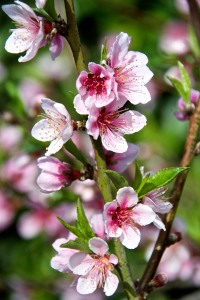
Our very low chill Florida Prince Peach tree is in full bloom here in early February. I have my hopes pinned on this tree for a stone fruit crop.
We now have six raised beds of various sizes for vegetables, a chicken coop and run with five hens, and a surprisingly diverse orchard.
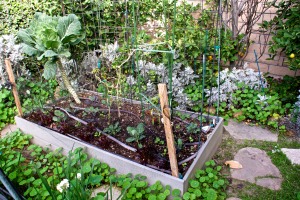
Raised vegetable bed #1, planted with collard greens, bell peppers, radishes, lettuce, cauliflower, red cabbage, snow peas, and a couple of onions.
Here are the fruit trees that are now growing in our yard, plus their winter chill hour requirements.But what are chill hours? Chill hours are the number of hours of cold (i.e. 45 degrees F or below) that are required to break down the growth-inhibiting hormones that cause a deciduous fruit tree to enter dormancy and stay dormant, so that normal growth can resume in the spring. A “low chill” variety is one with a 100-400 chill hours requirement.
Chill Requirements for the Fruit Trees
1 Apple, Fuji. 200-400 hrs
2 Apple, Gala. 200-500
1 Apple, Granny Smith. 400
1 Apricot, Katy. 200-300
1 Asian Pear, 20th Century. 300-400
1 Asian Pear, Sheinseki. 250-300
1 Asian Pear, 4 varieties grafted, 250-400
1 Avocado. 0
1 Blackberry. 100-500
Citrus. 0
2 Lemon, Eureka
1 Lemon, Meyer
2 Lime, Bearss
1 Orange, Navel
1 Orange, Valencia
2 Grape, Red Flame Seedless. 100+
1 Nectarine, Panamint. 250
1 Nectarine, Snow Queen 250-300
1 Peach, August Pride 100-200
1 Peach, Babcock Improved 250-300
1 Peach, Florida Prince 150
1 Peach, Garden Gold. 450-500
2 Persimmon, Fuyu 100-200
1 Plum, Santa Rosa 300-500
1 Pomegranate, 100-200
25 Total trees (not counting the grapes and blackberries, and not counting our olive tree, which we keep pruned so it doesn’t produce messy olives)
When selecting fruit trees, I paid attention to the number of chill hours that each variety required. We live in coastal Orange County, which is known for its moderate, pleasant climate: highs in the 70s, lows in the 50s, year round. But as you saw from the table above, most deciduous fruit trees need a certain amount of chilling in order to set fruit and remain healthy.
Microclimates affect chill hours. For example, in San Diego County, the average number of chill hours are:
- Coastal strip (within 10-15 miles of coast) = 50-250 chill hours
- Median areas (between 10 & 25 miles of coast – La Mesa, Clairemont, etc.) = 200-400 chill hours
- Inland areas (El Cajon, Spring Valley, Escondido, Jamul, etc.) = 400-600 chill hours (source: California Rare Fruit Growers, San Diego Chapter)
The folks at UC Davis Fruit and Nut Research Information keep track of chill hours for us, and track it thoughout the winter season (November through February). So far, we have had only 76 chill hours this 2014/2015 winter season, which isn’t enough for most of my deciduous fruit trees to set fruit. To check out their table, see
http://fruitsandnuts.ucdavis.edu/chillcalc/index.cfm
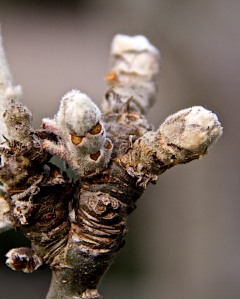
My apple trees are dormant this time of year, with buds that are not yet swollen. They usually bloom in May.
Global warming is definitely affecting the number of chill hours we receive. It is going to affect commercial growers as well. For example, chill hours in California’s Central Valley have declined by 22% over the past 60 years. Farmers and home orchardists may be wise to search out varieties with lower chill hours.
As acknowledgment of our changing climate, I chose to plant low chill Fuyu Persimmons and a pomegranate as the most recent additions to my orchard.
For more information on how to grow and care for fruit trees in southern California, I recommend this great PowerPoint from San Diego County.
Click to access Deciduous%20Fruit%20Trees%20in%20Southern%20California.pdf
I hope you enjoyed this overview of my mini-orchard of mostly dwarf and semi-dwarf fruit trees. They are still maturing, so I hope that their prime bearing years are still ahead of them.


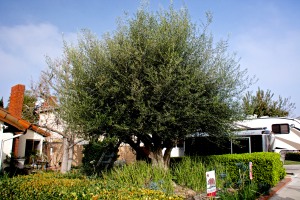
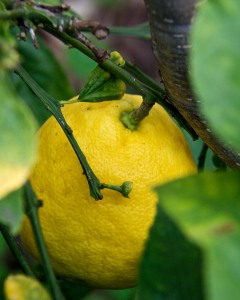


That’s a lot of fruit for your lot! I am really impressed.
LikeLike
Thanks, Crafty Christy. After I saw that video you recommended about apple trees in Uganda, I pulled last year’s leaves off three of my four apple trees. Sadly, I also broke two big branches off my dwarf Granny Smith in doing so. 😦 It has far more brittle branches than I was aware of. The apple trees don’t flower until May, so maybe that will be enough dormancy for them, who knows.
LikeLike
Thanks Lou for the book suggestion. I’ve read some of Kingsolver’s books, but didn’t know about this one.
I knew about the chill hours problem here, on the Orange County coast, but did not have the list. Thanks for that too. I once talked to a woman who worked at a local nursery about growing some eastern flowers–lilacs(??) I can’t remember now what they were, but she told me that she grew them by providing artificial chill to the roots. She said that on Halloween she starts putting large bottles of water in her freezer–two at a time, then she sets the two bottles on top of the soil, above the roots, around the base of the plant in such a way that the melt water slowly runs into the soil. Then she puts two more bottles in the freezer and switches them every 24 hours. I believe she said she did that until right after Thanksgiving, using the holidays as easy-to-remember dates. However I’m not sure about the time length she did it for. I did not try it. Has anyone tried it on stone fruit in this area?
I planted a bare root fuyu persimmon a year ago. It leafed out nicely in the summer and grew a bit, then went dormant in the fall. Now, in Feb., it’s still just a stick. My neighbor told me that it would be a while before I see fruit. She gets an amazingly large crop about every other year on a tree in a very small space. She keeps it cut back so much that it hardly looks like a tree.
Any advice on blueberries? Mine do well, produce a lot, but tend to die or die back a lot after about two years. They never get larger. I love them–I go out and pick my breakfast fruit nearly every morning–April through June. I’ve found that the type does not matter a lot. One variety does well one year, and another the next year. “Bountiful” was bountiful last year.
LikeLike
HB Farmer, thanks for the tip on the water bottles. What a great idea. I’m going to give that a try next year for my Asian Pear trees. As for how long, my chart gave the number of hours of chill that they needed. Some winters we get 300 or more hours of chill and the bottles wouldn’t be needed. But since we wouldn’t know until the end of the season whether or not those hours were met, doing it between Thanksgiving and Christmas should do it. I got a tip from CraftyChrist about pulling leaves off apple trees in the fall to simulate dormancy. It’s February and they won’t flower until May, so I pulled the leaves off three out of four apple trees. I’ll see if that makes a difference.
It will probably take at least three years for your persimmon to set fruit. The tree needs to put its energy into becoming a strong tree first. I have one that I have just about killed off due to not planting it in a timely fashion last year and a second one that I bought a couple of weeks ago that is still waiting for me to find time to plant it. It is going to be several years before I see any fruit from them.
As for blueberries, I haven’t had much luck with them. They died after 2-3 years. I think they require an adjustment to the pH of the soil, but I can’t remember if they like it alkaline or acidic. Probably acidic since my soil is alkaline. I may try them again in a different spot. I loved being able to pick my own blueberries while it lasted. But before I buy another blueberry bush, I need to get that persimmon tree planted.
LikeLike
Hello Lou, I live in Huntington Beach and I am a natural beekeeper. I live in an attached home and don’t have much of a yard. I have a beautiful beehive I am looking for a home. Currently it lives in a yard in Cudahy off the 710 with chickens, a cat and a dog and people. I hoping to bring it closer to home. Your garden would be paradise and it would help with fertilizing all your fruit trees. I wonder if you would consider hosting my hive. I would take care of it and share the honey harvest? It could be tucked in a corner or if you have any flat roof space. I love reading your blog. I hope someday I will have a yard and time to garden as you do. I can be reached at lmscotton@gmail.com. 714-797-7871. Sincerely Linda Scotton
Sent from my iPad
>
LikeLike
Linda, I wish I could help you out, but the city code won’t allow a beehive in a yard as small as mine. I think the code specifies 250 ft away from a dwelling, and we certainly don’t have that kind of space. We had a wild hive in our front yard olive tree once and the neighbors (two of them) asked us to remove them. Also, while my organic yard is safe for bees, birds, and butterflies, neighbors on two sides have a pesticide service that sprays for insects. I find dead bees on my sidewalk all the time. Sad. People seem so separated mentally from the natural world these days. The folks at Shipley Nature Center might be able to accommodate you though. Steve Engle is on Facebook and seems to be running the HB Central Park renovation these days. Friends of Shipley Nature Center can be found in the phonebook or on the internet. Good luck!
LikeLike
My goodness, I certainly wouldn’t call 25 trees a mini-orchard – and what an amazing variety! I hope you get those chill hours or at least the leaf removing trick works for you – it’s such a disappointment when fruit trees don’t produce.
LikeLike
Margaret, it is too soon to tell if the leaf removal trick will work. We got a few more chill hours last night with temps down in the low forties. Maybe that will help the trees that haven’t bloomed yet. This is all a learning experience for me.
LikeLike
I too am impressed at the number of fruit trees you have on your small lot. Looking forward to learning if the leaf removing trick worked. The water bottle idea is certainly worth a try.
LikeLike
Norma, small lot, small trees. The poundage of fruit harvests isn’t all that impressive, but we have a good variety. And my orchard is still young. It should just get better with time.
LikeLike
No shortage of winter chill hours here… 😉
LikeLike
Hahaha, Leduesorelle. No, you have no shortage of winter chill, especially this year.
LikeLike
That is a lot of fruit trees. I wish I had the space for that many. I espalier many of mine up the fence to conserve space. Though I don’t have to worry about chill hours here. I can pretty much plant anything.
LikeLike
I am in awe of your beautiful fertile garden and so many well kept trees in such a small space.. although I am visiting in California I live in central Illinois and the cold we get there is brutal, i have no idea how anything survives. I love your old olive tree. c
LikeLike
Thanks, Cecilia. I try to do the best I can with our small space. I was raised in Indiana and have lived in Colorado and Connecticut. It was hard to adapt to this different California life style with houses on such small lots.
LikeLike